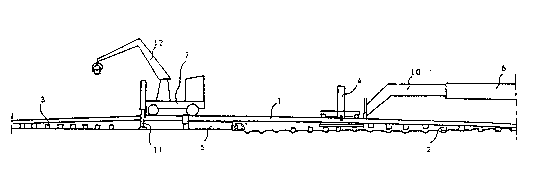Some of the information on this Web page has been provided by external sources. The Government of Canada is not responsible for the accuracy, reliability or currency of the information supplied by external sources. Users wishing to rely upon this information should consult directly with the source of the information. Content provided by external sources is not subject to official languages, privacy and accessibility requirements.
Any discrepancies in the text and image of the Claims and Abstract are due to differing posting times. Text of the Claims and Abstract are posted:
| (12) Patent Application: | (11) CA 2112122 |
|---|---|
| (54) English Title: | METHOD FOR CHANGING RAILWAY SLEEPERS AND EQUIPMENT FOR APPLYING THE METHOD |
| (54) French Title: | METHODE DE REMPLACEMENT DE TRAVERSES DE CHEMIN DE FER ET MATERIEL UTILISE POUR CE FAIRE |
| Status: | Deemed Abandoned and Beyond the Period of Reinstatement - Pending Response to Notice of Disregarded Communication |
| (51) International Patent Classification (IPC): |
|
|---|---|
| (72) Inventors : |
|
| (73) Owners : |
|
| (71) Applicants : | |
| (74) Agent: | KIRBY EADES GALE BAKER |
| (74) Associate agent: | |
| (45) Issued: | |
| (86) PCT Filing Date: | 1992-06-23 |
| (87) Open to Public Inspection: | 1993-01-07 |
| Examination requested: | 1999-06-23 |
| Availability of licence: | N/A |
| Dedicated to the Public: | N/A |
| (25) Language of filing: | English |
| Patent Cooperation Treaty (PCT): | Yes |
|---|---|
| (86) PCT Filing Number: | PCT/FI1992/000197 |
| (87) International Publication Number: | WO 1993000477 |
| (85) National Entry: | 1993-12-21 |
| (30) Application Priority Data: | ||||||
|---|---|---|---|---|---|---|
|
2112122 9300477 PCTABS00019
The object of the invention is a method for changing railway
sleepers. In this method the sleepers (2) of the rails (1) are
removed and new sleepers (3) are put in place. By using a lifting
device (4) the rails (1) are lifted, at the same time they are
loosened from the sleepers, the sleepers (2) are removed from under the
rails and new sleepers (3) are brought under the rails and the
railway ground is levelled by using a plough (5) which is placed
under the rails (1) and which is pulled by the working machine (6).
In addition, the object of the invention is equipment which
permits the application of the method. At present, changing sleepers
is slow and it requires much time to move equipment on to and off
from the line. In the method, according to the invention, the
plough (5) is used as a foundation base on which the rails rest
during the work, and the plough can be left under the lifted railway
section when the work has to be interrupted so that trains can
run over it. In the equipment, according to the invention, the
working machine (7) has supporting stands (11) which support it when
it is lying on top of the rails, and during the work the working
machine and the plough have been arranged to support the railway
line.
Note: Claims are shown in the official language in which they were submitted.
Note: Descriptions are shown in the official language in which they were submitted.

2024-08-01:As part of the Next Generation Patents (NGP) transition, the Canadian Patents Database (CPD) now contains a more detailed Event History, which replicates the Event Log of our new back-office solution.
Please note that "Inactive:" events refers to events no longer in use in our new back-office solution.
For a clearer understanding of the status of the application/patent presented on this page, the site Disclaimer , as well as the definitions for Patent , Event History , Maintenance Fee and Payment History should be consulted.
| Description | Date |
|---|---|
| Inactive: IPC from MCD | 2006-03-11 |
| Application Not Reinstated by Deadline | 2002-06-25 |
| Time Limit for Reversal Expired | 2002-06-25 |
| Deemed Abandoned - Failure to Respond to Maintenance Fee Notice | 2001-06-26 |
| Letter Sent | 1999-09-07 |
| Inactive: Application prosecuted on TS as of Log entry date | 1999-09-07 |
| Inactive: Status info is complete as of Log entry date | 1999-09-07 |
| Request for Examination Requirements Determined Compliant | 1999-06-23 |
| All Requirements for Examination Determined Compliant | 1999-06-23 |
| Application Published (Open to Public Inspection) | 1993-01-07 |
| Abandonment Date | Reason | Reinstatement Date |
|---|---|---|
| 2001-06-26 |
The last payment was received on 2000-06-07
Note : If the full payment has not been received on or before the date indicated, a further fee may be required which may be one of the following
Please refer to the CIPO Patent Fees web page to see all current fee amounts.
| Fee Type | Anniversary Year | Due Date | Paid Date |
|---|---|---|---|
| MF (application, 5th anniv.) - small | 05 | 1997-06-23 | 1997-06-09 |
| MF (application, 6th anniv.) - small | 06 | 1998-06-23 | 1998-06-15 |
| MF (application, 7th anniv.) - small | 07 | 1999-06-23 | 1999-05-27 |
| Request for examination - small | 1999-06-23 | ||
| MF (application, 8th anniv.) - small | 08 | 2000-06-23 | 2000-06-07 |
Note: Records showing the ownership history in alphabetical order.
| Current Owners on Record |
|---|
| JAAKKO NIIRANEN |
| Past Owners on Record |
|---|
| None |